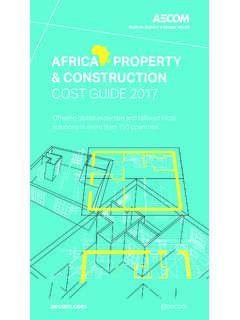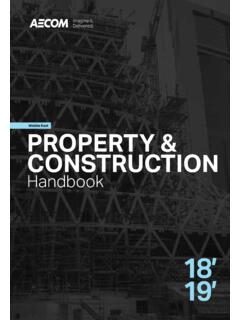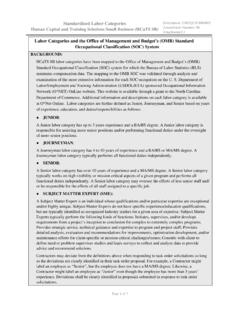Transcription of Cost model Modular construction - AECOM
1 Cost modelModular constructionAn edited version of this article first appeared in Building magazine in April 2017 Contents 1. Background 042. Modular construction 053. Design 074. Procurement and construction 085. Cost influencers 106. Sustainability 117. The cost model 15 All images:Ladywell, Lewisham Council (Rogers Stirk Harbour + Partners)Rob MillsDirector, Program Cost Consultancy, about Modular construction and off-site manufacture are nothing new.
2 But with more suppliers, better quality and greater awareness within the industry, could it finally achieve critical mass? Rob Mills of AECOM looks at the author would like to thank Barry Nugent, James Barton and Garry Burdett of AECOM for their help in preparing this | Cost model | Modular construction | April 2017 | 4It may have had different names over the years prefabrication, Modular building, design for manufacture and assembly, or off-site construction but the idea of constructing buildings away from the site where they will eventually stand has had a long history, dating as far back as the 16th century. The postwar pushPerhaps the most notable use of Modular construction was during the UK s post-war transitional period, which drove the need for homes and accelerated the search for a remedy to meet the country s housing supply issues.
3 The legacy of that building programme survives today, with many of those postwar homes still that period, redundant arms factories were adapted to allow ex-servicemen and women to produce prefabricated housing in controlled factory conditions. This addressed the pre-existing housing supply problems and targeted employment issues an idea that would surely resonate this was an opportunity missed. A relatively small number of houses were delivered in that post-war push. Technological innovations were not adopted, and so there was little change to the development of the the high-riseThroughout the 1950s and early 1960s, demand for housing was a result of major slum clearances in inner cities. This set a precedent for government housing targets and saw the introduction of a large-panel residential systems on high-rise blocks, based on their successful application in first use of such systems was a nine-block residential scheme commissioned by the London Borough of Newham using the Larsen-Nielsen system.
4 The subsequent progressive collapse of the structure in the Ronan Point block led to concerns around durability and structural performance. This only added to existing negative views of methods of prefabricated construction . 01 BackgroundThe most notable use of Modular construction was during the UK s post-war transitional | Cost model | Modular construction | April 2017 | 5 Times are a-changingFast-forward to present day, and things have changed. Performance is now more than credible. Quality is very good and viability assessments are encouraging when compared with a traditional cost estimates suggest that, for medium-size schemes, Modular construction could be 10-20% more cost effective than traditional methods. In the past, the Modular approach has been seen to cost more and this can be attributed to designers trying to fashion a design for a traditional build into something that fits with the Modular approach.
5 This doesn t always work and economical projects have been designed as Modular from the Modular supply chain is still fairly immature. However, Modular suppliers themselves have very strong supply chains and so can compete on price versus their traditional appealIt is no surprise that interest in this approach is gaining traction. Contractors like the enhanced health and safety benefits gained from having less heavy and time-consuming construction work occurring on site and the logistical challenges eased, especially when faced with tight inner-city sites where storage or lay-down areas are sometimes non-existent. There is also less managers like the lean, on-site programmes that result from off-site manufacture. Developers often approve of the reduced finance charges and the revenue streams flowing from the earlier marketing and viewing of completed homes that all sounds too good to be true.
6 But the usual hurdles around quality perception have been resolved and investors are placing cash and expectation into expanding drawdown of social housing grants by social registered landlords and earlier completion also make this approach more attractive, where applicable. With an earlier and faster completion, the additional costs associated with inflation and cost escalation is minimised by reduced contract duration. 02 Modular construction10 -20%Cost estimates for medium-size schemes, Modular construction , more cost effective than traditional | Cost model | Modular construction | April 2017 | 6 All- Modular , finally?The government is also interested in Modular construction , notably in the potential for upping the bandwidth of housing delivery and closing the gap between supply and demand, which is at the forefront of the current industry debate.
7 Add to that the prospect of mitigating the skills shortage across the industry as a whole not to mention an estimated 20-30% decline in skilled labour over next decade due to migration and retirement and it s no wonder that Modular construction s time is has taken a while to reach fruition. Modern methods of construction has been industry jargon for years, but until recently the percentage of schemes completed using these methods was stuck in the single prefabrication and off-site construction bathroom pods, MEP elements, facades and the like have helped larger, traditional schemes make time and cost savings. But wholesale adoption has been slow, held back in part by negative perceptions around quality and product , economies of scale seen as standard in manufacturing industries suddenly seem achievable.
8 Pure Modular projects, usually based around timber-framed structures, are now a reality, with their standardised components and on-site installation making for a safe, efficient and sustainable situationThe recently published government white paper (Fixing a broken housing market, February 2017), talks about how the UK needs 225,000-275,000 or even more homes to be built per year in order to keep up with population growth. This gives an indication as to what the Modular market size could the same report, the government announced that there will be made available for housing associations and non-profit making developers to assist with funding such projects, along with a further for private developers from the housing infrastructure fund. A broad range of developers are exploring this methodology, especially for multibuilding sites where standardised, repetitive floor plates work conditions often dictate that affordable accommodation is built first when delivering a multi-block and mixed tenure site.
9 Typically, with margins on lower-value sites being tight, the efficiencies that Modular construction brings can improve viability is a developing sector within the industry, which does have challenges . There is still a limited supply chain, with around six sufficiently mature manufacturers able to support projects whose order books are full and a number of off-site manufacturers are keen to enter the Modular approach, however, is scalable. Factories are generally located in the Midlands and require very limited equipment and low utility capacity to set up. They assemble a kit of parts, rather than manufacturing anything themselves. A mixture of skilled and semi-skilled labour is required and quality is tightly controlled under factory conditions by the moment very few large-scale projects have been executed, and these are typically low-rise, affordable , engineers are now exploring the possibilities of building to 20 storeys plus (logistics and access permitting) and producing private tenure blocks with efficient massing.
10 More and higher-profile schemes are sure to come on line in the future. 20-30%Estimated decline in skilled labour over next decade due to migration and | Cost model | Modular construction | April 2017 | 7To many designers, Modular buildings always look like Modular buildings and the stigma of post-war prefabs may take time to shake off. Architects and their design teams will need to develop better facade details for private-tenure Modular schemes to become possible. Clearly, some premium architects have been nurturing this idea for a while now, and foresee the opportunity and usually consist of a timber or lightweight steel frame held together using heavy-duty brackets. A sub floor and outer ceiling is then inserted using timber joists or a metal equivalent, with finishes applied afterwards.











